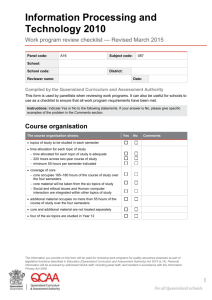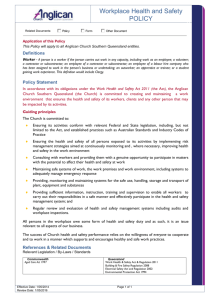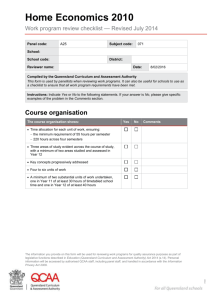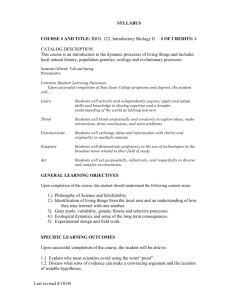Work program review checklist - Queensland Curriculum and
advertisement
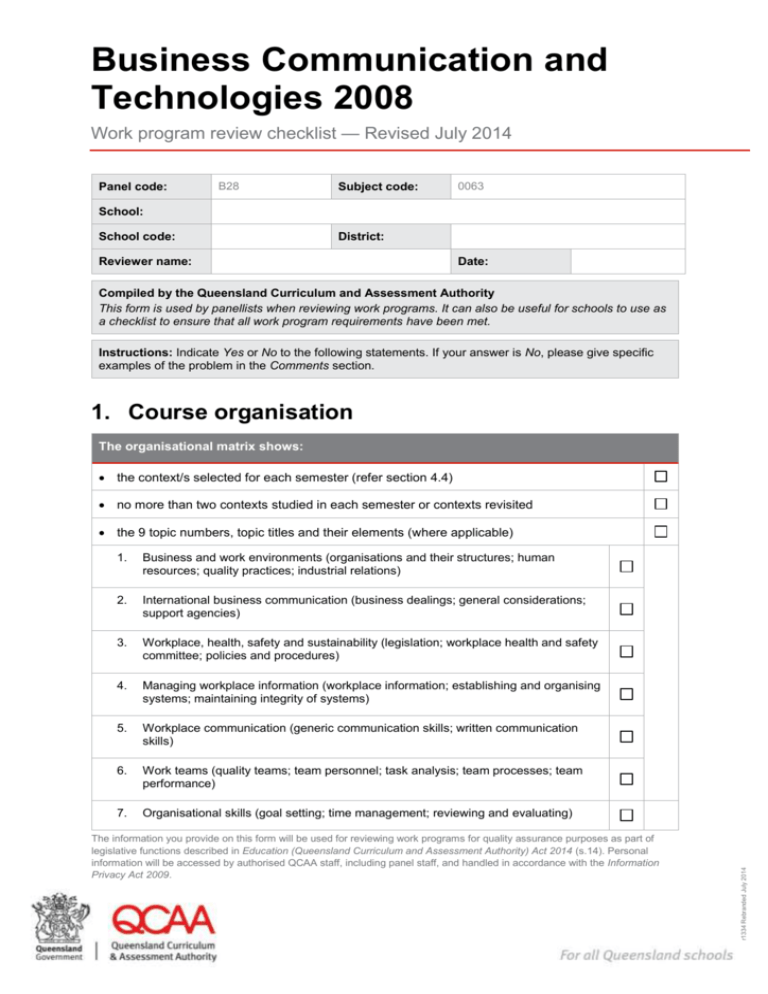
Business Communication and Technologies 2008 Work program review checklist — Revised July 2014 Panel code: B28 Subject code: 0063 School: School code: District: Reviewer name: Date: Compiled by the Queensland Curriculum and Assessment Authority This form is used by panellists when reviewing work programs. It can also be useful for schools to use as a checklist to ensure that all work program requirements have been met. Instructions: Indicate Yes or No to the following statements. If your answer is No, please give specific examples of the problem in the Comments section. 1. Course organisation The organisational matrix shows: the context/s selected for each semester (refer section 4.4) no more than two contexts studied in each semester or contexts revisited 1. Business and work environments (organisations and their structures; human resources; quality practices; industrial relations) 2. International business communication (business dealings; general considerations; support agencies) 3. Workplace, health, safety and sustainability (legislation; workplace health and safety committee; policies and procedures) 4. Managing workplace information (workplace information; establishing and organising systems; maintaining integrity of systems) 5. Workplace communication (generic communication skills; written communication skills) 6. Work teams (quality teams; team personnel; task analysis; team processes; team performance) 7. Organisational skills (goal setting; time management; reviewing and evaluating) The information you provide on this form will be used for reviewing work programs for quality assurance purposes as part of legislative functions described in Education (Queensland Curriculum and Assessment Authority) Act 2014 (s.14). Personal information will be accessed by authorised QCAA staff, including panel staff, and handled in accordance with the Information Privacy Act 2009. r1334 Rebranded July 2014 the 9 topic numbers, topic titles and their elements (where applicable) 8. Computer operations (word-processing routine; word processing advanced; spreadsheets; databases OR electronic presentations) 9. Financial records (banking procedures; petty cash; source documents) the topics to be studied in each semester the 12 units of competency and their elements (where applicable) BSBOHS201A — participate in OHS processes BSBWOR202A — organise and complete daily work activities BSBCMM201A — communicate in the workplace BSBWOR203A — work effectively with others BSBWOR204A — use business technology BSBINM201A — process and maintain workplace information FNSICGEN305B — maintain daily financial/business records BSBITU201A — produce simple word-processed documents BSBITU202A — create and use spreadsheets BSBSUS201A — participate in environmentally sustainable work practices BSBITU303A — design and produce text documents BSBITU301A — create and use databases BSBITU302A — create electronic presentations the approximate time allocation for each topic a minimum 55 hours per semester a clear indication of which Computer Operations elective will be covered an appropriate balance between: topics 1 to 4 — at least one topic studied in each semester topic 8 — topic to be studied in each semester topic 9 — topic to be spread over a minimum of two semesters (at least once in Year 12) Additional comments Business Communication and Technologies 2008 Work program review checklist — Revised July 2014 Queensland Curriculum & Assessment Authority July 2014 Page 2 of 4 2. Outline of intended student learning Does the intended student learning provide sufficient opportunities for students to experience the scope and depth of the general objectives in the syllabus? Two contextualised units of study from Year 11 or 12 must be submitted and include: the recommended subject matter from the selected topic/s of study the context/s for the unit examples of context-based learning experiences coverage of the general objectives Comments: 3. Assessment plan The assessment plan conforms with the principles of exit assessment (Section 7.1) (e.g. balance, continuous assessment, mandatory aspects of the syllabus, significant aspects of the course, selective updating, fullest and latest) and shows: each assessment instrument to be administered the semester the topic number, title and the topic elements (where applicable) the assessment technique to be used the criteria in which student achievement is to be assessed that the criterion being assessed is appropriate for the assessment technique that the terminology used in the assessment plan is consistent with the range of assessment techniques stated in the syllabus each criterion is assessed in each semester a range of assessment techniques will be used the assessment conditions, e.g. approximate time (in minutes, number of lessons, e.g. 3–4 x 40 mins) and/or appropriate word length — according to syllabus requirements the verification folio requirements will be met, including: 4–6 summative assessment instruments from Year 12 each criterion assessed summatively at least twice by verification Business Communication and Technologies 2008 Work program review checklist — Revised July 2014 Queensland Curriculum & Assessment Authority July 2014 Page 3 of 4 one extended written response under supervised test conditions assessing Reasoning Processes one significant assessment instrument of either an extended written response (research) or an integrated project a substantial computer operations assessment instrument Comments: The sample student profile: indicates whether results are formative or summative allows for the recording of: standards awarded for individual assessment instruments for each criterion (this must reflect the assessment plan) interim global standards at monitoring and verification exit global standards exit level of achievement Comments: Additional comments Recommendation for approval Approved Not approved Action to be taken: Business Communication and Technologies 2008 Work program review checklist — Revised July 2014 Queensland Curriculum & Assessment Authority July 2014 Page 4 of 4

